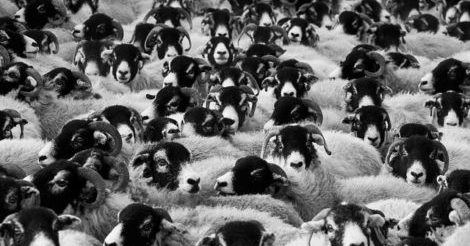
Before they were one of the most famous archaeological discoveries (and narratives), the Dead Sea Scrolls were so many unsuspecting sheep, goats, and cows. Sure, there are some important steps in between, but for today’s purposes, the animals are key. Since the parchments are made of animal hide, they have DNA. And DNA can survive for the ~2,000 years since the scrolls were written, allowing researchers to extract DNA from tiny samples or crumbs to learn about the animals who gave their hide for the parchment. You can read a news summary here, or the full paper here.
This is an intersection of science and religion that had never occurred to me. I had heard previously of using phylogenetic methods to understand how and when and where variations in various texts arose. In that case, the words of the manuscript are “genomes” being analyzed. But here it is the literal DNA of the manuscripts, helping to answer questions about which fragments likely belong to the same original document and which likely had separate origins. For example, parchments made from cowhide are considered unlikely to have originated near where the scrolls were found, because the local climate does not currently support the raising of cattle and there is little evidence that was different 2,000 years ago. And since some of the cowhide fragments turned out to be associated with Jeremiah texts already considered distinct from Jeremiah fragments on sheepskin, the contents of the documents seem to corroborate that conclusion.
I also appreciated the demonstration of interdisciplinary research. There can be a tendency to treat DNA as the final word on, well, whatever topic it is applied to. Take for example the CSI effect in criminal proceedings, which gives forensic DNA evidence extra weight in many jurors’ minds. Here, however, the discussion takes into consideration the significant body of work already available on the scrolls and tries to find a way to complement it with what can be learned from the DNA. And while also acknowledging the limitations of the DNA evidence, including the degradation that comes with 2,000 years and the potential for contamination by humans who have handled the fragments post-discovery. Although oddly enough, the degradation gives the parchment DNA distinct features that can actually help distinguish it from modern contamination.
Finally, the story of how the collaborators met at Tel Aviv University, striking up a conversation on a bus during new faculty orientation, made me think about Francis Su’s discussion of the levers of change in our fields. He talked about carpooling as a way to foster conversation across disciplines and also beyond work-related talk. Whether via shared transportation or some other means, it got me thinking about how important it is to create space for new dialogues if you want to generate new solutions.
To that end, I wanted to acknowledge the ShutDownStem activities going on today. I think taking the time today to have these conversations and do the work will make our STEM communities more productive in the long run, because more of us will be able to participate and benefit.
Related, if you missed the live conversation on the intersection of science and race that I mentioned last week, you can find the recording here:
Finally, I found a lot to think about in this podcast conversation touching on several topics, including the need to make sure that our models of infectious diseases are detailed enough to provide insights that benefit all of us.
Andy has worn many hats in his life. He knows this is a dreadfully clichéd notion, but since it is also literally true he uses it anyway. Among his current metaphorical hats: husband of one wife, father of two teenagers, reader of science fiction and science fact, enthusiast of contemporary symphonic music, and chief science officer. Previous metaphorical hats include: comp bio postdoc, molecular biology grad student, InterVarsity chapter president (that one came with a literal hat), music store clerk, house painter, and mosquito trapper. Among his more unique literal hats: British bobby, captain’s hats (of varying levels of authenticity) of several specific vessels, a deerstalker from 221B Baker St, and a railroad engineer’s cap. His monthly Science in Review is drawn from his weekly Science Corner posts — Wednesdays, 8am (Eastern) on the Emerging Scholars Network Blog. His book Faith across the Multiverse is available from Hendrickson.

Leave a Reply